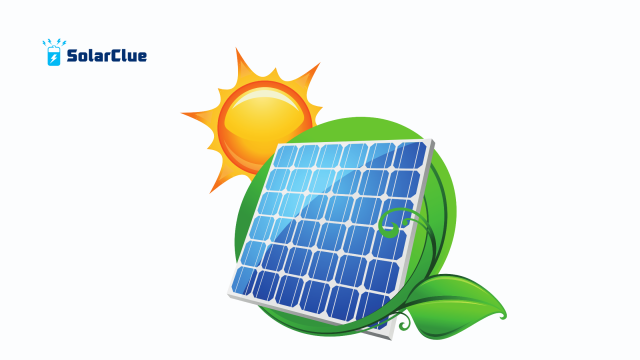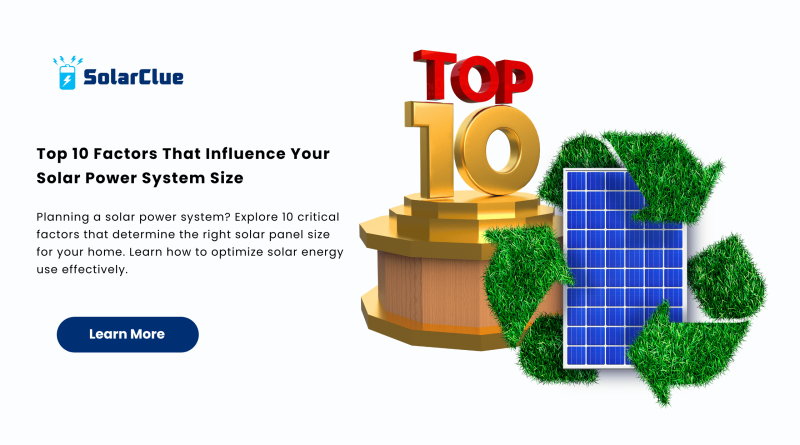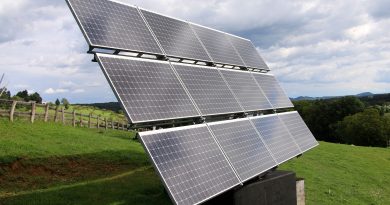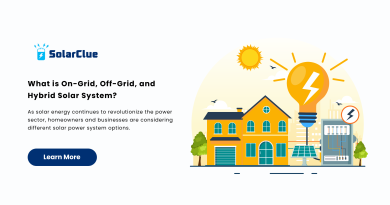Top 10 Factors That Influence Your Solar Power System Size
Choosing the right size for your solar power system is crucial to maximizing efficiency, return on investment, and long-term savings. Several key variables determine how many solar panels you need and what kind of setup works best for your home.
Table of Contents
- 1 1. Your Monthly Electricity Consumption
- 2 2. Available Roof Space
- 3 3. Location & Peak Sun Hours
- 4 4. Panel Efficiency
- 5 5. Type of Solar Panel
- 6 6. Energy Storage Requirements
- 7 7. Budget Constraints
- 8 8. Government Subsidies and Net Metering
- 9 9. Expected Increase in Future Usage
- 10 10. Inverter Capacity
- 11 Bonus: Professional Energy Audit
- 12 Other Tips for Optimizing Your Solar Setup
- 13 Environmental & Economic Benefits
- 14 FAQs
- 15 Final Thoughts
1. Your Monthly Electricity Consumption
Understanding your average kWh usage gives the baseline for sizing your system. Analyze the last 6–12 months of your electricity bills to get a reliable estimate. A higher average consumption naturally requires more solar panels to compensate.
2. Available Roof Space
Your roof’s usable area will directly impact the number of panels you can install. Consider obstructions such as water tanks, chimneys, or AC units. Flat and south-facing pitched roofs are ideal. Use a professional assessment or satellite imaging tool for accuracy.
3. Location & Peak Sun Hours
Geographic location plays a pivotal role. Places like Gujarat, Rajasthan, and Tamil Nadu enjoy higher solar irradiance, often exceeding 5.5 hours per day. In contrast, places with frequent cloud cover or hilly terrain might only receive 3–4 hours of effective sunlight.
4. Panel Efficiency
The best solar panel brands feature high-efficiency monocrystalline technology, converting more sunlight into electricity. While they cost more, they save roof space and provide better performance in low-light conditions. Look for panels with efficiency ratings above 20%.
5. Type of Solar Panel
Monocrystalline panels are sleek, efficient, and best suited for limited roof space. Polycrystalline panels are bulkier but more affordable, offering a good compromise between cost and performance. Thin-film panels, while flexible and lightweight, are less common for residential rooftops.
6. Energy Storage Requirements
Adding a battery storage system allows you to store excess solar energy for use at night or during outages. Lithium-ion batteries are the most common choice due to their efficiency and durability. Factoring in battery needs will increase overall system size and cost.
7. Budget Constraints

Your financial capacity can impact not only how many solar panels you can afford but also the type and quality. While the upfront cost may seem high, consider long-term savings and financing options like loans or EMIs. Opt for a scalable system if you’re planning future upgrades.
8. Government Subsidies and Net Metering
India offers generous subsidies under MNRE and various state programs. These reduce upfront costs by up to 40% in some cases. Net metering policies allow you to export surplus electricity to the grid, giving you credits and boosting ROI.
9. Expected Increase in Future Usage
Whether you’re planning to install new air conditioners, purchase an electric vehicle, or increase your home size, account for this in your solar power system design. Oversizing the inverter and leaving room on your mounting structure can save you from costly upgrades.
10. Inverter Capacity
Your inverter converts DC from solar panels into AC for home use. It should match or slightly exceed your panel output. Modern inverters come with smart monitoring, helping you track energy production and consumption through apps or online portals.
Bonus: Professional Energy Audit
A solar audit by a certified installer or provider is essential. They’ll assess your site, analyze shading and orientation, and recommend an optimal system size. This ensures better performance and full use of available subsidies and policies.
Other Tips for Optimizing Your Solar Setup
- Clean panels regularly to ensure peak output.
- Trim trees or remove obstructions that cause shading.
- Install panels at the right angle and orientation.
- Monitor your system for performance drops.
Environmental & Economic Benefits
Investing in solar energy reduces your dependency on fossil fuels. A 5kW residential system can offset nearly 6 tons of CO₂ annually. Plus, you’ll enjoy consistent energy savings, protection from tariff hikes, and improved property value.
FAQs
Q1. What is the ideal number of solar panels for a 3BHK home?
Typically, 8–12 panels depending on usage and location, assuming 400W panels and 5 hours of peak sunlight.
Q2. Can I start small and add panels later?
Yes. Many systems are modular. Ensure your inverter is sized for future expansion.
Q3. What’s better: fewer high-efficiency panels or more budget panels?
It depends. Fewer high-efficiency panels save space but cost more upfront. More budget panels may require more roof space and maintenance.
Q4. How long until I see ROI on my solar investment?
Typically between 4 to 7 years depending on your state’s solar policy, energy use, and subsidies.
Q5. How can I estimate my savings?
Use tools on SolarClue to calculate savings based on location, panel type, and usage. Professional quotes also provide detailed projections.
Q6. How do government subsidies work for solar?
Subsidies are routed through your solar provider and credited upfront or post-installation. States have specific percentages and eligibility requirements.
Q7. Are solar panels weather-resistant?
Yes, modern solar panels are tested to withstand heavy rain, high winds, and hail. They are IP67 rated and designed for long-term outdoor exposure.
Q8. Can I run appliances like refrigerators or air conditioners on solar?
Absolutely. A well-sized system can power all home appliances, including energy-intensive devices like ACs and washing machines.
Final Thoughts
Sizing your solar power system isn’t a one-size-fits-all approach. By accounting for all the key factors—roof space, panel efficiency, budget, future usage, and location—you can build a system that meets your energy goals efficiently and affordably.
Interested in sustainable energy that pays for itself? Visit blog.solarclue.com for expert advice or explore top-rated solar products and services at solarclue.com today!




